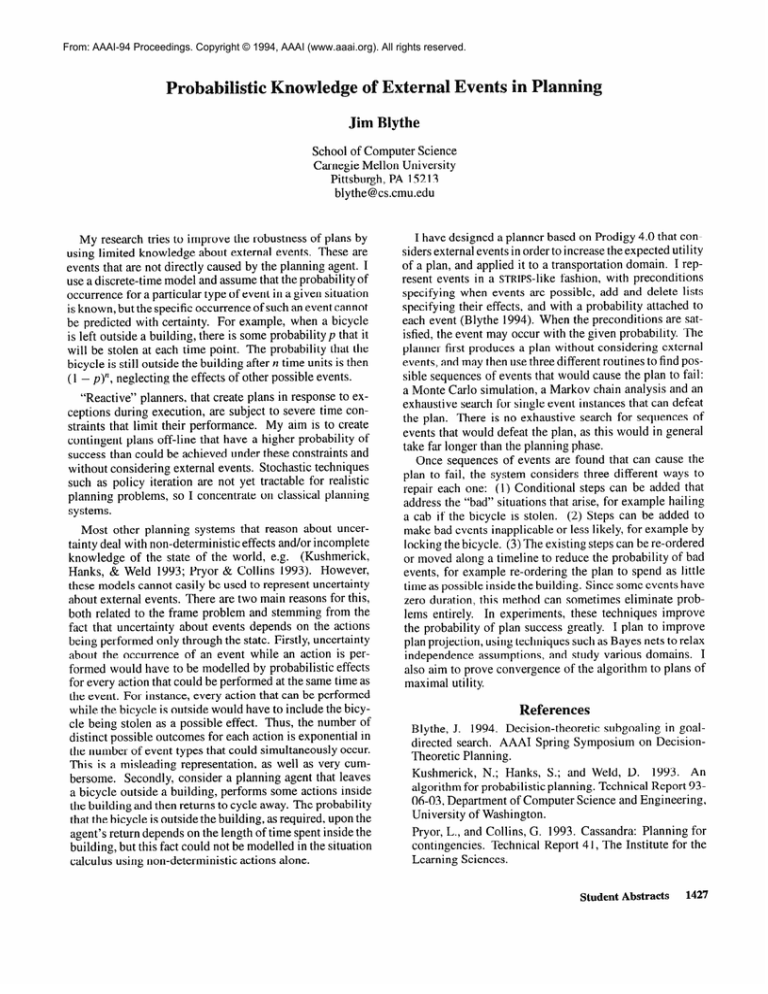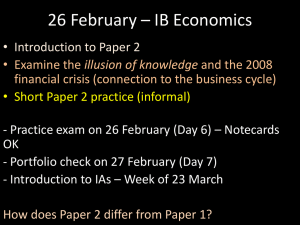
From: AAAI-94 Proceedings. Copyright © 1994, AAAI (www.aaai.org). All rights reserved.
Probabilistic
Knowledge of External Events in Planning
Jim Blythe
School of Computer Science
Carnegie Mellon University
Pittsburgh, PA 15213
blythe@cs.cmu.edu
My research tries to improve the robustness of plans by
using limited knowledge about external events. These are
events that are not directly caused by the planning agent. I
use a discrete-time model and assume that the probability of
occurrence for a particular type of event in a given situation
is known, but the specific occurrence of such an event cannot
be predicted with certainty. For example, when a bicycle
is left outside a building, there is some probability p that it
will be stolen at each time point. The probability that the
bicycle is still outside the building after n time units is then
(1 - p)“, neglecting the effects of other possible events.
“Reactive” planners, that create plans in response to exceptions during execution, are subject to severe time constraints that limit their performance.
My aim is to create
contingent plans off-line that have a higher probability of
success than could be achieved under these constraints and
without considering external events. Stochastic techniques
such as policy iteration are not yet tractable for realistic
planning problems, so I concentrate on classical planning
systems.
Most other planning systems that reason about uncertainty deal with non-deterministic
effects and/or incomplete
knowledge of the state of the world, e.g. (Kushmerick,
Hanks, & Weld 1993; Pryor & Collins 1993). However,
these models cannot easily be used to represent uncertainty
about external events. There are two main reasons for this,
both related to the frame problem and stemming from the
fact that uncertainty about events depends on the actions
being performed only through the state. Firstly, uncertainty
about the occurrence of an event while an action is performed would have to be modelled by probabilistic effects
for every action that could be performed at the same time as
the event. For instance, every action that can be performed
while the bicycle is outside would have to include the bicycle being stolen as a possible effect. Thus, the number of
distinct possible outcomes for each action is exponential in
the number of event types that could simultaneously occur.
This is a misleading representation,
as well as very cumbersome. Secondly, consider a planning agent that leaves
a bicycle outside a building, performs some actions inside
the building and then returns to cycle away. The probability
that the bicycle is outside the building, as required, upon the
agent’s return depends on the length of time spent inside the
building, but this fact could not be modelled in the situation
calculus using non-deterministic
actions alone.
I have designed a planner based on Prodigy 4.0 that considers external events in order to increase the expected utility
of a plan, and applied it to a transportation domain. I represent events in a STRIPS-like fashion, with preconditions
specifying when events are possible, add and delete lists
specifying their effects, and with a probability attached to
each event (Blythe 1994). When the preconditions are satisfied, the event may occur with the given probability. The
planner first produces a plan without considering external
events, and may then use three different routines to find possible sequences of events that would cause the plan to fail:
a Monte Carlo simulation, a Markov chain analysis and an
exhaustive search for single event instances that can defeat
the plan. There is no exhaustive search for sequences of
events that would defeat the plan, as this would in general
take far longer than the planning phase.
Once sequences of events are found that can cause the
plan to fail, the system considers three different ways to
repair each one: (1) Conditional steps can be added that
address the “bad” situations that arise, for example hailing
a cab if the bicycle is stolen. (2) Steps can be added to
make bad events inapplicable or less likely, for example by
locking the bicycle. (3) The existing steps can be re-ordered
or moved along a timeline to reduce the probability of bad
events, for example re-ordering the plan to spend as little
time as possible inside the building. Since some events have
zero duration, this method can sometimes eliminate problems entirely. In experiments, these techniques improve
the probability of plan success greatly. I plan to improve
plan projection, using techniques such as Bayes nets to relax
independence assumptions, and study various domains. I
also aim to prove convergence of the algorithm to plans of
maximal utility.
eferences
Blythe, J. 1994. Decision-theoretic
subgoaling in goaldirected search. AAAI Spring Symposium on DecisionTheoretic Planning.
Kushmerick, N.; Hanks, S.; and Weld, D. 1993. An
algorithm for probabilistic planning. Technical Report 9306-03, Department of Computer Science and Engineering,
University of Washington.
Pryor, L., and Collins, G. 1993. Cassandra: Planning for
contingencies.
Technical Report 41, The Institute for the
Learning Sciences.
Student Abstracts
1427






